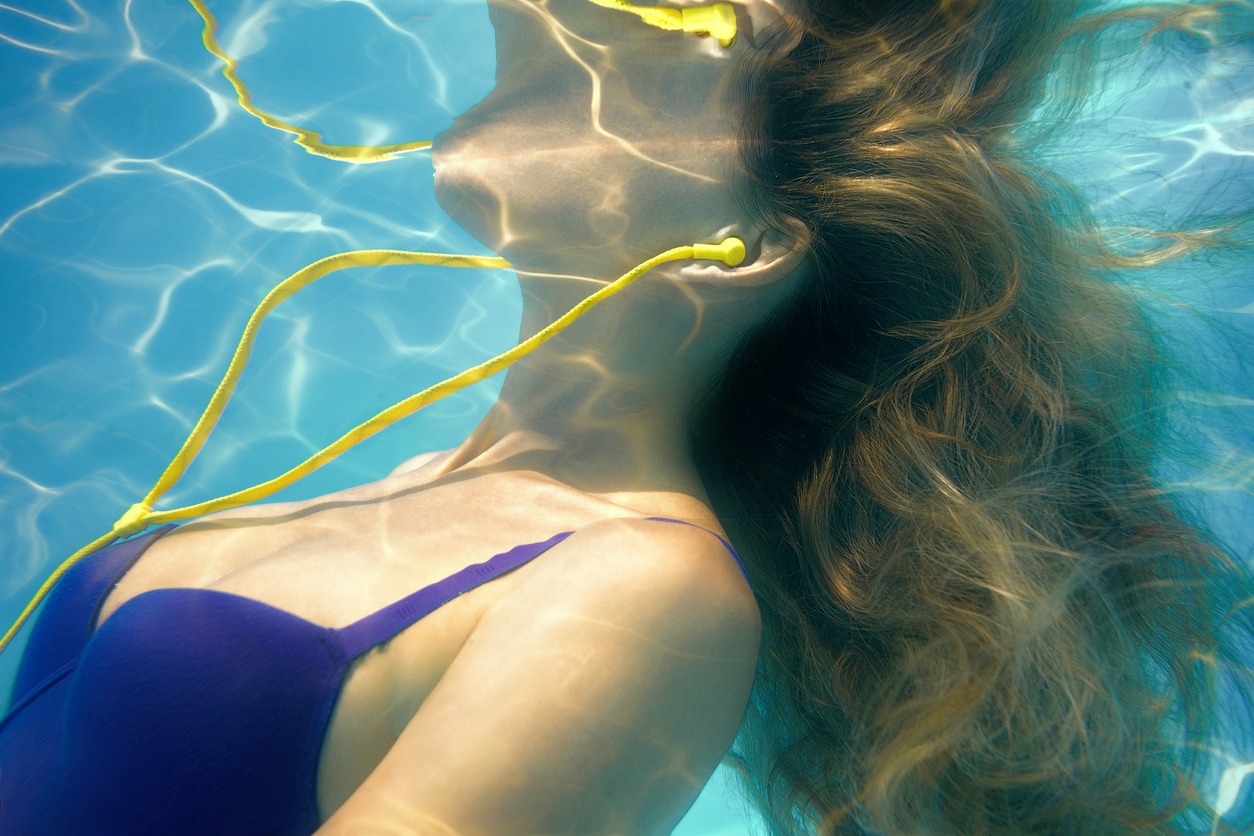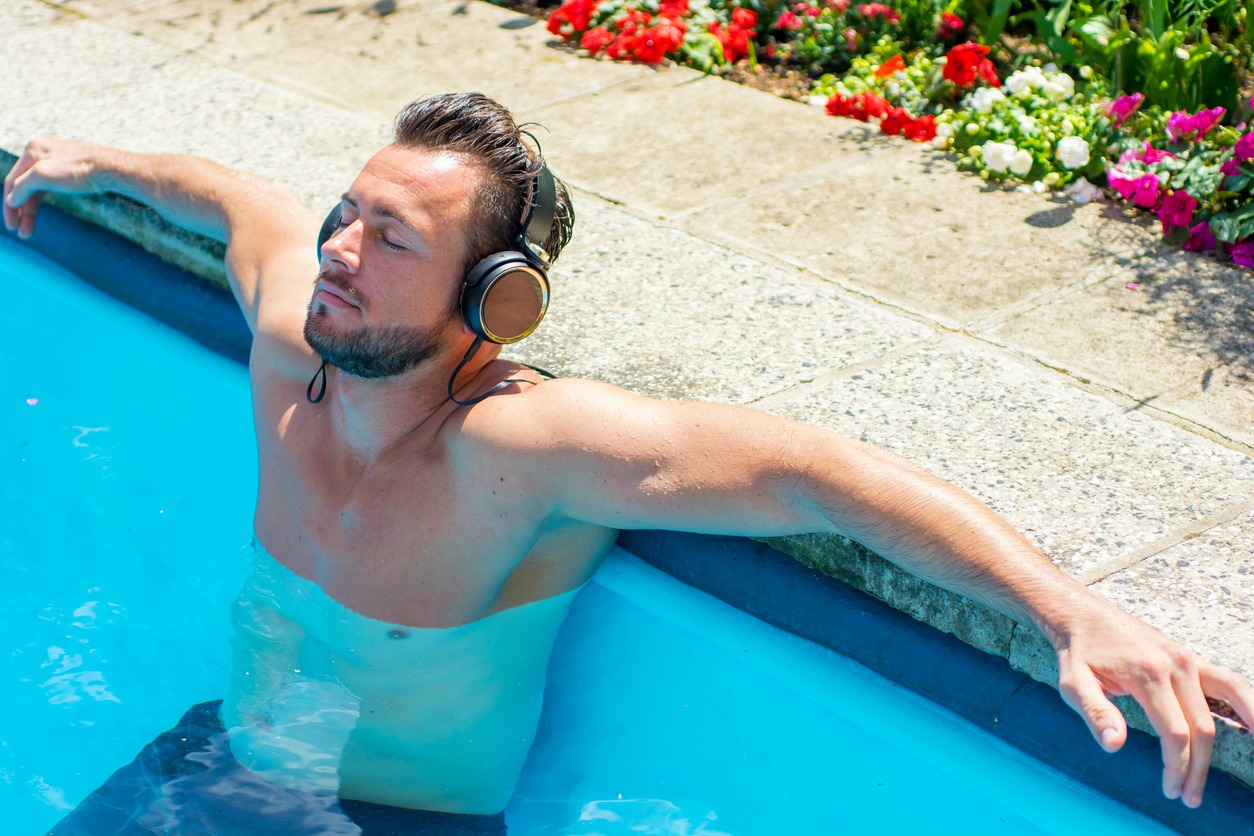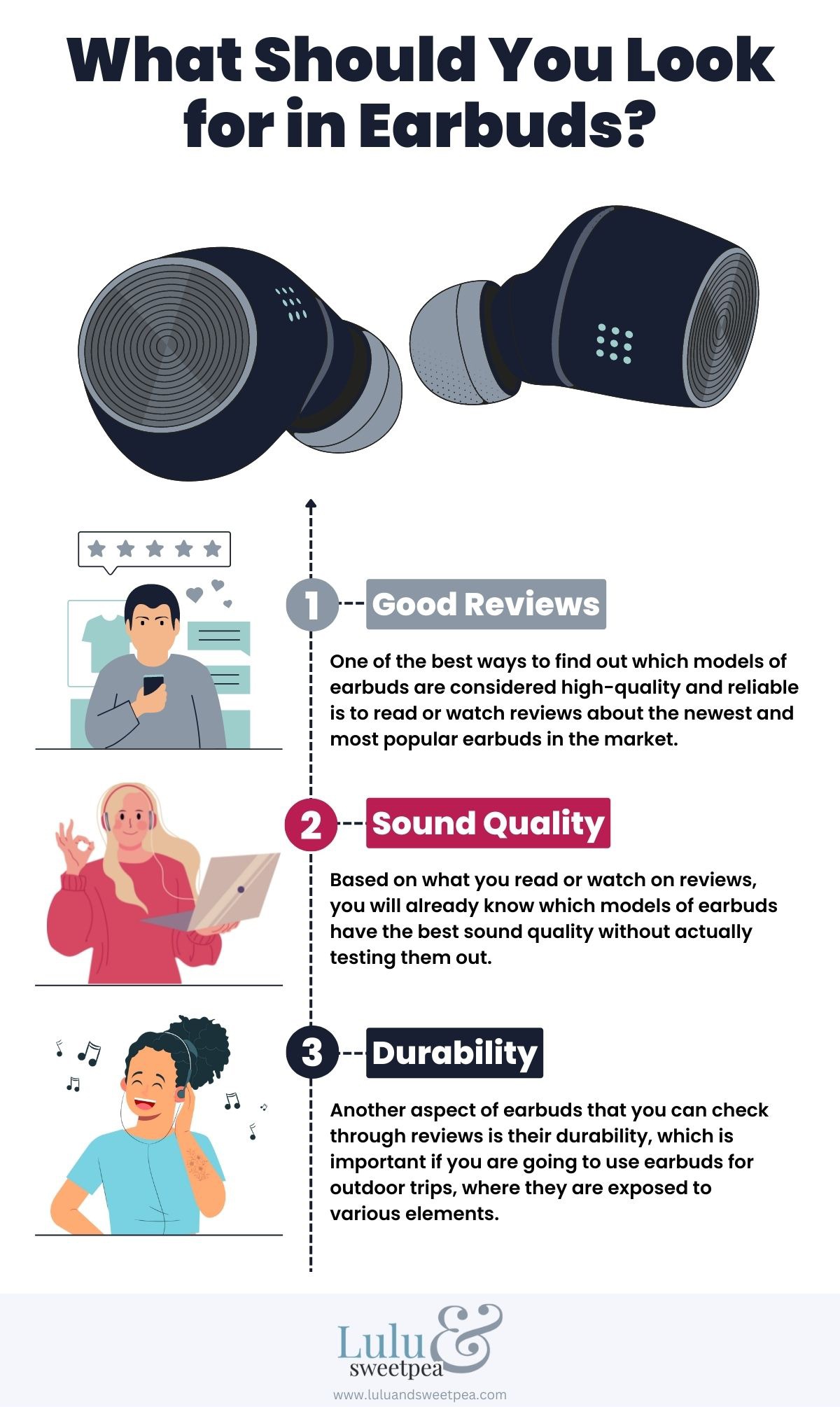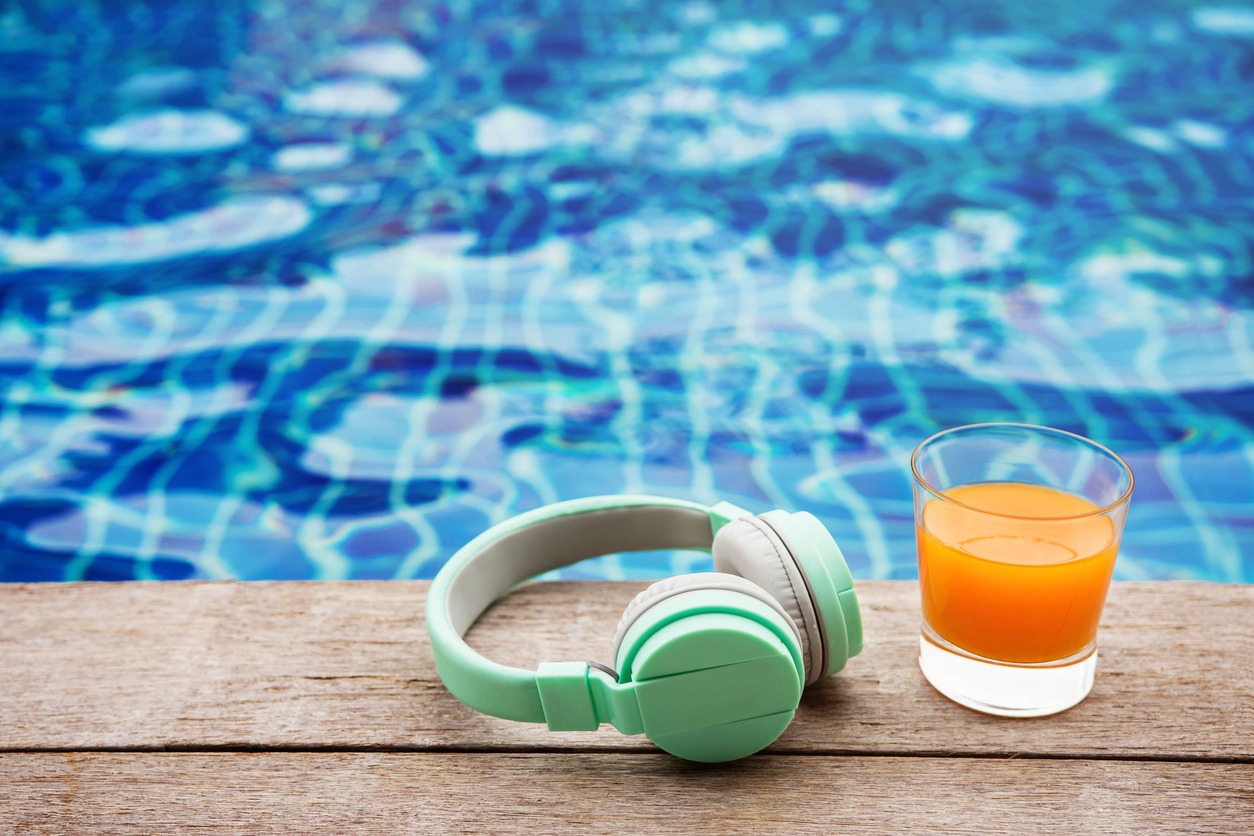Listening to music when exercising is a great way to get more out of your workouts. But if you’re doing your swimming laps at the pool or water jogging at the beach, a speaker blasting sounds in the air may not suffice. When you’re underwater, you may not hear sounds coming from the beach or poolside because very little sound passes from air to water. So, if you got company listening to music you both like, you will not enjoy it while swimming because it will sound muffled.
For you to be able to listen to music while swimming, you need underwater earbuds. It will help you focus on your swims and maximize your time underwater. Picking the right earbuds for your water activities comes down to choosing the right features and the right way to deliver that sweet music to your ears.
Factors to Consider When Shopping for Waterproof Earbuds
Buying waterproof earbuds for swimming is not as easy as choosing a casual earphones for daily use. Of course, there are general tips about what you should look for in earbuds, which apply to waterproof ones, such as:
But besides these factors, here are some key factors to consider when picking out the right waterproof earbuds or headphones:
Purpose
Before purchasing waterproof headphones, it is important to consider the primary purpose of using them. If your activities involve training for a triathlon or frequently swimming laps, it is recommended that you opt for waterproof headphones that have their own storage or MP3 player. This is the most effective way to immerse yourself in audio while swimming fully. If you choose a pair that relies on Bluetooth technology, you may experience interrupted audio, even if you are using a small pool and your phone is nearby.
IP (Waterproofing) Rating
Sadly, even the best headphones in the market aren’t really underproof. To be able to listen to music while swimming, you need waterproof headphones.
The industry standard for waterproofing is the IP (Ingress Protection) rating, which indicates the level of protection against liquids. It’s important to note that water-resistant and waterproof ratings are not the same, with water-resistant devices best suited for moist environments and waterproof devices being able to handle extended submersion in water.
For swimming, it’s recommended to choose headphones and music players with an IPX7 rating or higher to avoid device damage. An IPX8 rating is ideal for extended submersion. A rating of IPX7 means the device has been submerged in depths up to 1 meter, while a rating of IPX8 indicates that the device has been tested at a depth of at least 1 meter. Given that most swimmers don’t go below a meter when swimming, an IPX7 works for most swimmers. For maximum peace of mind, an IPX8 is ideal.
When evaluating IP ratings, pay attention to the second digit, which indicates the level of water resistance, while the first digit shows the level of dust protection. The X in an IPX rating is a placeholder for 0, and it’s important to note that manufacturers tend to focus more on protection against liquids than dust. While the highest level of water resistance may not be necessary for most people, ensuring that your headphones or earbuds have a modest IP rating and useful features such as active noise cancellation or an adjustable EQ is crucial.
Size
Finding the right size earbuds can be a difficult task, as ears come in many different shapes and sizes. In addition to being waterproof, headphones must form a water tight seal to deliver sound directly to your eardrum without distortion. If water enters between the earbud tip and your eardrum, the audio quality will be compromised and sound muffled, making it hard to hear.
Since ear canals vary in size and shape, it’s important to have a variety of earbud tip sizes to achieve a snug and secure fit while swimming. Many quality headphones come with multiple tip sizes to ensure everyone can enjoy high-quality sound while swimming.
Eartip fit
Eartips come in different styles, including:
- Round silicone tips – These are the most common type of ear tips that come with earbuds. They are flexible and comfortable, creating a seal in your ear canal to improve sound quality and noise isolation.
- Memory foam tips – These are similar to silicone tips but made from memory foam instead. They mold to the shape of your ear canal for a snug and secure fit.
- Double-flange tips – These have two flanges that extend into your ear canal to create a better seal. They provide more noise isolation than regular silicone tips.
- Triple-flange tips – These have three flanges and are similar to double-flange tips but offer even more noise isolation.
- Winged tips – These ear tips have small wings that fit into the ridge of your outer ear to provide a more secure fit. They are especially useful for active people who need their earbuds to stay in place.
You may need to try out a few to see what you like, but ultimately, it needs to have a watertight seal and have a comfortable fit in your ears so you don’t have to worry about a stray earbud sinking to the bottom of the pool while you’re doing swim laps. Some may come with an ear hook to be more secure.
Integrated music player
Consider your music source when choosing headphones for swimming, as Bluetooth connectivity may not work well underwater. Some options come with built-in MP3 players, while others use an FM transmitter or a cable to plug into a portable MP3 player. If you prefer streaming, look for headphones with an FM transmitter.
When choosing headphones for swimming, you have the option of standalone devices or those with integrated music players. It’s important to consider what type of device you want to use for storing music (MP3, streaming, etc.) and whether it’s compatible with your current subscriptions and music collection format. While the type of headphones you choose is important, selecting a waterproof MP3 player specifically designed for swimming is the best choice if you opt for wired waterproof earbuds. This option also ensures that you won’t have to worry about the battery life limitations that come with integrated MP3 players on waterproof headphones.
Care and Maintenance
Once you own a waterproof headphone, you must take care of it well to keep it performing well for a longer time. Here are some care and maintenance tips for waterproof headphones:
Remove the headphones from the plug rather than the cord
Sometimes when we use headphones, we get lazy and tend to grab the cord and yank. Before you know it, the wires are pulled much to the point that the sound degrades or disappears entirely. Always grasp the plug itself when removing headphones to lengthen their lifespan.
Rinse clean and pat dry after use
After each use, rinse the headphones with clean water and pat them dry. Regardless of where you swim, other substances will be in the water, such as chlorine, salt, and unfamiliar microorganisms. To keep your headphones in good condition, it’s best to wash them off before leaving them to sit. A brief rinse with a showerhead or faucet can make a significant difference. Finally, use a towel or paper towel to dry them off.
Avoid extreme temperatures
Do not leave your earphones outside or in the car to be exposed to the elements. If you’re going to take your headphones while skiing in the snow or iceberg surfing, make sure to keep your earphones indoors after. Also, did you know that on a 100° F (38° C) day, the inside of a car can reach 172° (78° C)? That’s really hot! So, do not leave your headphones out there when not in use.
Store in a clean, dry location
There are carrying cases for headphones or earbuds that you can use to store them properly. If you keep them as it is, the cords may get tangled with your other belongings. For instance, when stored in a bag, a regular earbud can get lost and tangled along with your pens and comb. But if it has proper storage, you can keep it intact.
The same goes for waterproof earphones. You’ll want to take care of it better because it’s a more expensive investment than a regular earbud.
Frequently Asked Questions (FAQs)
Do Bluetooth headphones work while swimming?
Although Bluetooth headphones are great for listening to music in the air, they are not suitable for use underwater as they can only transmit sound for a few inches in the water. As much as we would like to leave our phones at the edge of the pool and connect our headphones via Bluetooth, it’s not feasible. This leaves us no other option but to transfer MP3 songs or download playlists to a waterproof device, whether a separate player or headphones with a built-in music player.
What IP rating should I go for?
Electronics undergo testing to determine their level of water resistance, and their IP rating indicates this. The format of an IP rating is IPXX, with the second digit representing the device’s protection against liquids. A rating of IPX8 indicates that the device can withstand submersion at a depth of 1 meter or more, while IPX7 indicates protection against submersion up to 1 meter. Since most swimmers don’t typically go deeper than 1 meter, an IPX7 rating is usually sufficient. However, an IPX8 rating would be the ideal choice for those seeking maximum assurance.
Is there a difference between waterproof and water-resistant headphones?
Water-resistant headphones can handle some exposure to water, such as sweat or light rain, but they are not designed to be submerged in water. On the other hand, waterproof headphones can be submerged in water for a certain period of time and still function properly. The degree of water resistance is often indicated by an IP rating, which stands for Ingress Protection, followed by two digits. The first digit indicates the degree of protection against solids, while the second digit indicates the degree of protection against liquids. A higher second digit indicates a higher degree of water resistance or waterproofness.
A product’s waterproof or water-resistant capabilities are measured through IP ratings, with the final digit indicating the level of protection against liquids. For instance, IPX5-rated products can withstand water jetting from a 6.3mm nozzle, while IPX6-rated products can handle water jets from a 12.5mm nozzle.
However, exposing headphones with these ratings to heavy faucet pressure or submerging them is not advisable. To be considered waterproof, a product should have an IPX7 rating, which can withstand being submerged up to one meter for 30 minutes. IPX8 earphones are becoming increasingly popular, with the ability to survive at depths of one to three meters for longer periods.
How to do your charge waterproof earphones?
Waterproof earphones are more common than on-ear or over-ear headphones for several reasons. In the category of in-ear earphones, there are truly wireless earphones, as well as traditional wireless models with cables that connect the earpieces while still streaming wireless audio. It’s important to note that the charging case for your truly wireless earphones is usually not waterproof.
Some charging cases have waterproof exteriors, but few have a waterproof interior, with the second-generation AirPods Pro case being a notable exception. It’s risky to dock wet earphones, so you must exercise caution. Wireless models with cables don’t have this problem, but their waterproof ratings generally only apply when the charging port is closed.
You must use common sense when it comes to waterproof earphones. When charging, treat your earphones as if they aren’t water-resistant, and dry the port before connecting the cable and the earpieces before placing them in the case.
How much should you spend on waterproof earbuds?
Nowadays, having a reliable IP rating doesn’t seem to significantly impact the price of headphones. However, if water resistance is essential to you, the top-performing models we have tested typically begin at around $100. The pricier options usually come with advanced features like top-notch noise cancellation or premium audio quality.
For those on a tighter budget, you can refer to our list of the best headphones we’ve tested for under $50, but bear in mind that they may not be water-resistant. Once you’ve found the right pair, take a look at our additional coverage on five simple tips to prolong the life of your headphones and the eight ways you might be using your headphones incorrectly.
Can listening to waterproof headphones speed up my swims?
It has been proven that listening to music while swimming can enhance your swimming performance. Sprint efforts and longer distance swims have both shown improvements while listening to music, according to various studies1. Listening to music can also increase rhythm, stroke rate, and power output and boost endurance by up to 15%. These findings suggest that listening to music while swimming can be quite beneficial.




